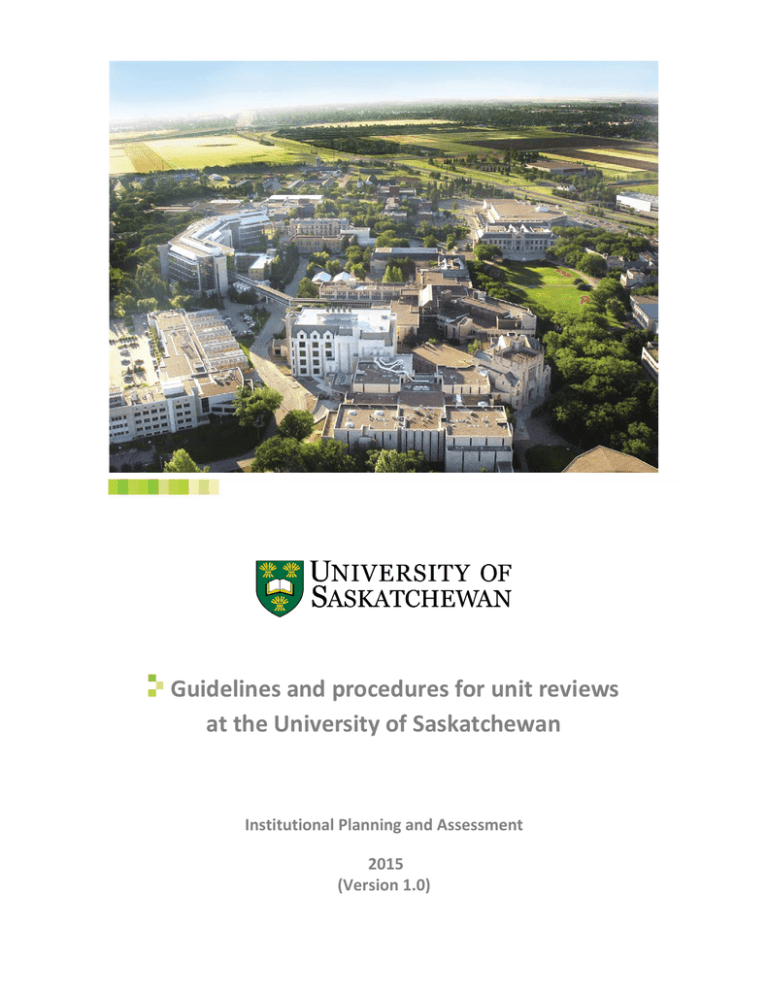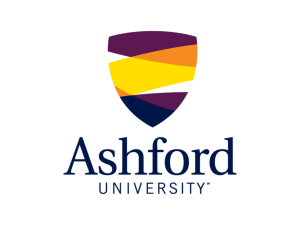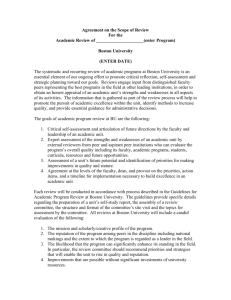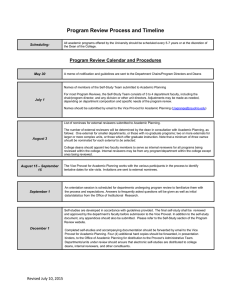Guidelines and procedures for unit reviews at the University of Saskatchewan
advertisement

Guidelines and procedures for unit reviews at the University of Saskatchewan Institutional Planning and Assessment 2015 (Version 1.0) TABLE OF CONTENTS 1. Introduction ..................................................................................................................................................... 3 2. Purpose ............................................................................................................................................................ 3 3. Scope ................................................................................................................................................................ 4 4. Timeline............................................................................................................................................................ 4 5. Definitions ........................................................................................................................................................ 6 6. Roles and responsibilities ................................................................................................................................ 6 7. Confidentiality .................................................................................................................................................. 7 8. Phases of the review process ........................................................................................................................... 7 Phase 1: Identification of the unit ............................................................................................................. 8 Phase 2: Self-study and selection of reviewers ......................................................................................... 9 Phase 3: External review ........................................................................................................................... 11 Phase 4: Responses to review ................................................................................................................... 13 Phase 5: Follow-up .................................................................................................................................... 14 2015 (Version 1.0) Guidelines and procedures for unit reviews Page 2 of 14 1. INTRODUCTION As outlined in the Framework for Assessment: Beyond Systematic Program Review (2008), review of the various academic, administrative and operational units that comprise the University of Saskatchewan is of upmost importance and demonstrates the university’s continued commitment to ensuring that programming and services are of the highest quality. In particular, undertaking systematic review activities will lead to: • • • • improved student learning and development improved quality in program and service offerings increased creative research and scholarly endeavors alignment with institution-wide goals (Framework for Assessment, 2008) The university’s commitment to undergoing systematic review activities is in line with the standard presented by the Saskatchewan Higher Education Quality Assurance Board (SHEQAB) in which it is stated that, “The institution implements a periodic external program review and assessment process to ensure the ongoing currency of the program and the quality of its learning outcomes” (Quality Assurance Review Process: Program Review Standards and Criteria, 2014, p. 8) In order to assist with the review process, this document outlines the roles and responsibilities of all parties involved in the review process, and offers guidelines and procedures to follow. In particular, contained in the guide is an overview of the scope, timelines and detailed information outlining the five phases of the review process. 2. PURPOSE Three broad purposes for assessment at the University of Saskatchewan were outlined in the Framework for Assessment and guide the current guidelines and procedures for reviews (herein referred to as the guide). Listed below are the three purposes, along with a brief description of each (please refer to the Framework for Assessment for additional information): Quality improvement Primarily a formative process, quality improvement refers to the commitment to bring performance and agreed upon goals into closer alignment. While this type of assessment activity is continuous in nature, concentrated efforts should coincide with cycles of integrated planning. Quality assurance Primarily a summative process, quality assurance is the periodic testing of performance against expectation. Assessments of performance may take place at any time, but deans, vice-presidents and others should take advantage of natural opportunities, such as accreditation cycles and changes in leadership. The selective unit reviews to be conducted will primarily be for this purpose. 2015 (Version 1.0) Guidelines and procedures for unit reviews Page 3 of 14 Accountability Accountability represents our commitment to openness and transparency and refers to regular communication about outcomes, successes and failures. 3. SCOPE In addition to outlining the purpose of reviews at the University of Saskatchewan, the Framework for Assessment also identified guiding principles which, in part, pertain to the scope of assessment activities to be carried out. In particular, the Framework for Assessment states that: The university should undertake a comprehensive and inclusive array of assessment initiatives such that academic and administrative units, services, programs and activities are all subject to appropriate forms of review. (Framework for Assessment, p. 3) This guide will provide instructions for conducting reviews of the various units, programs and functions that make up the University of Saskatchewan. Furthermore, the focus of a selective review may have an administrative orientation (e.g., Human Resources), service orientation (Food Services) or may focus on an area that is defined by diverse organizational, operational and program characteristics (e.g., Information Technology Services, Student Advising, International Student and Study Abroad Centre). For the purposes of this guide, academic units, administrative units, services, programs and activities will be referred to as the unit. In recognition of the diversity of organizational units and functions on campus, a standardized yet flexible approach to the review process will be outlined, wherein specific unit-based guidelines will be provided as necessary, and templates will be adaptable dependent upon the unit under review. 4. TIMELINE The intent is for units to be reviewed on a regular basis. This objective is in line with the Saskatchewan Higher Education Quality Assurance Board which recommends that post-secondary institutions will undergo periodic review of their activities (Quality Assurance Review Process, 2014). Based on this, it is feasible that a number of units at the University of Saskatchewan would be subject to a review each year. When scheduling reviews, efforts will be made to time them to coincide with unit accreditation and to balance their respective objectives. The list of scheduled reviews will remain updated and posted on the University of Saskatchewan’s review webpage. Upon notifying a unit, the review process should take approximately 8-12 months to complete. 1 The timeline below identifies the key phases of the review. 1 In special circumstances, this timeline may be expedited. 2015 (Version 1.0) Guidelines and procedures for unit reviews Page 4 of 14 Unit review: timeline of key activities PHASE 1: indentification of the unit - Provost announces the review - Initial meeting with IPA - Terms of reference developed PHASE 2: self-study and selection of reviewers - IPA provides relevant data to unit and self-study report completed - Nominations for review team members submitted 3 weeks after review initiated - 2 or 3 external reviewers and 1 internal reviewer selected PHASE 3: external review - Review team receives self-study 6 weeks prior to site visit - Review team conducts 2 to 3 day site visit - External review report submitted 4 weeks after site visit PHASE 4: responses to review - Response from provost received 4 weeks after receiving unit's response - Response to review report submitted by unit 4 weeks after receiving report PHASE 5: follow-up - IPA conducts survey to assess the review process 2015 (Version 1.0) - Action plan developed and periodic updates provided to provost Guidelines and procedures for unit reviews Page 5 of 14 5. DEFINITIONS Institutional Planning and Assessment (IPA): IPA has been assigned the tasks of coordination and integration of university-level planning initiatives. The office will provide leadership, design the process of the review, maintain an inventory of reviews, and integrate and communicate outcomes by conducting institutional analysis. In addition, IPA will provide support to units under review and will coordinate the resources necessary to have reviews completed in a timely and accurate manner. Program: The term program is used to describe an undergraduate or graduate degree program. Unit: A unit is responsible for the administration of undergraduate and/or graduate programs. A unit may be a department, a non-departmentalized faculty or an entity such as an interdisciplinary program that is not easily categorized within the faculty structure. Unit leader: The unit leader is the person responsible for the unit. He or she may be a department head, a dean, or, for example, the director of an interdisciplinary program. Review team: The review team is normally composed of three or four reviewers—two or three external reviewers (national and international) and one internal University of Saskatchewan reviewer. 6. ROLES AND RESPONSIBILITIES In order to facilitate the successful implementation of the review process, a coordinated effort from several offices across campus is necessary. Described below is a brief list of the roles and responsibilities of the various stakeholders involved in the selective unit reviews. Unit under review • Propose the names of potential external reviewers • Propose the names of potential internal reviewers Complete a self-study document using the template provided Work with IPA staff to prepare for the site visit Participate in site visit meetings and other opportunities for feedback (e.g., staff/faculty survey) Provide a response to the external review report Develop a strategic plan and follow-up on the external reviewers’ recommendations as necessary • • • • • Unit leader • • • Approve the list of potential external and internal reviewers provided by the unit Meet with the review team during their site visit Provide a response to the external review report Version 1.0 (2015.06) Guidelines and procedures for unit reviews Page 6 of 14 Information and Communication Technology, Data Services (ICT-DS) • Assist in providing relevant data and statistics required for each unit review Institutional Planning and Assessment (IPA) • • • • • • Provide the overall coordination of the unit review process Develop a terms of reference for each specific unit review, to be approved by the provost and unit leader Populate the self-study document with the relevant data provided by ICT Implement a current student survey, alumni survey and any other feedback mechanisms as required for the unit under review Handle all administrative arrangements pertaining to the site visits Maintain an inventory of completed unit reviews and of the main findings from each review Provost and vice-president academic (provost) • • • • Determine which units to be reviewed Approve the schedule for reviews Notify units of upcoming review Provide a written commentary on the external review report and unit’s response 7. CONFIDENTIALITY Information on planned, scheduled and completed reviews will be posted on the university’s review webpage. It is left to the discretion of the provost and unit under review to determine whether or not they wish to post the full records of the review process including self-study, external review report and responses to the report. In posting any materials associated with the review, all confidential elements will be removed before posting. In addition, review team members will be asked to sign a confidentiality agreement upon appointment to the review team. 8. PHASES OF THE REVIEW PROCESS Contained in this section is an overview of each phase of the unit review process, from identifying the unit(s) for review, to communicating results following the completion of the unit review. In the sections following, detailed information is provided for each of the phases and there is also reference to the templates to be used by the relevant stakeholders involved in the unit review. 2015 (Version 1.0) Guidelines and procedures for unit reviews Page 7 of 14 PHASE 1: IDENTIFICATION OF THE UNIT During the first phase of the review process, the following activities will take place: • • • • • The provost, and others as determined, will select the unit under review and the provost will notify the unit they have been selected for a review. Units may also self-identify an interest in conducting a selective review if doing so will assist with guiding anticipated change or renewal of a unit. A terms of reference will be developed that outlines the specific purpose of the unit’s review. Following selection and notification of the unit, IPA will meet with the unit leader in order to review the roles and responsibilities of all stakeholders involved in the review. The unit will be provided with an electronic version of the selective unit review guidebook and accompanying templates needed to complete the review. 2015 (Version 1.0) Guidelines and procedures for unit reviews Page 8 of 14 PHASE 2: SELF-STUDY AND SELECTION OF REVIEWERS Self-study A key element of the review process is the self-study, wherein the goal is to provide a critical analysis of the unit’s performance, including strengths and weaknesses, desired improvements and future directions (Saskatchewan Higher Education Quality Assurance Board, 2013). While the need for additional resources may be noted, the description of improvements and future directions should be confined to existing resources or the reallocation of resources. In addition, the self-study should make reference to the unit’s alignment with the university’s strategic directions and current integrated plan. The self-study should be concise and clear with a maximum limit of 30 pages, not including appendices. Further, the process of preparing the report should include all relevant stakeholders: faculty, students and staff. A template for the self-study will be provided to the unit under review, in which central data and statistics will be included. 1. Timeframe of the self-study The timeframe for the data included in the self-study begins five years prior to the last academic year completed before a unit review is undertaken. For example, a unit review starting in September 2015 will include data from the 2010/11 academic year to the 2014/15 academic year. 2. Submission of the self-study Following completion of the self-study, the unit will provide IPA with: • one complete electronic copy IPA will provide a copy of the report to: • the provost and to the dean/director of the unit under review • the review team A copy of the self-study report will be included in the inventory of reviews kept by IPA. Selection of reviewers A review team is required for every selective unit review and will consist of: • • Two or three external reviewers who are internationally recognized within relevant disciplines. Experience in administration, curriculum or unit reviews is an asset. Usually, these reviewers will be from post-secondary institutions in Canada or the United States. One internal reviewer within the University of Saskatchewan. The internal reviewer will serve primarily as a resource person during the site visit and will not participate in writing the external review report. 2015 (Version 1.0) Guidelines and procedures for unit reviews Page 9 of 14 Once the unit is notified of the upcoming review, members of the unit under review will begin the process of proposing the names of potential external reviewers and potential internal reviewers. This list will then be approved by the unit leader and the completed review team nomination forms will be forwarded to IPA. Please note, the unit head is not to contact potential reviewers. IPA will work with the provost and/or dean/director to select and contact the reviewers from the list provided. In addition, IPA may suggest additional names if requested by the provost. As outlined in further detail in the review team nomination guidelines, it is important that reviewers are at arm’s length from the unit under review and to avoid any perception of a conflict of interest. Therefore, all connections to the unit under review, be they personal, familial or professional, must be considered. 2015 (Version 1.0) Guidelines and procedures for unit reviews Page 10 of 14 PHASE 3: EXTERNAL REVIEW Once the review team has been identified, IPA, in collaboration with the unit leader, will be responsible for organizing a site visit of the unit under review. IPA will provide the review team with electronic copies of the terms of reference, self-study report, a site visit schedule and other relevant documents, such as integrated planning documents, program and curriculum information, and survey results 2. Site visit The review team will complete a site visit of the unit under review which will take place over a two to three day period. Listed below is information pertaining to the budget and activities included in the site visit. • • • • • The budget for each site visit will include the cost of travel, accommodations, meals and honoraria. Each external reviewer will receive an honorarium. All reasonable expenses associated with the review incurred by the external reviewers will be paid for by IPA. The reviewers will be introduced to each other at the beginning of the first day or, time permitting, will have a dinner meeting on the evening prior to starting the review. The initial meeting should include the provost and vice-president academic and the director of institutional effectiveness from IPA. The purpose of this meeting is to meet the review team and provide information about the purpose and structure of the review and the roles of the participants. During the site visit, the unit leader should be available to meet with the review team as needed. In addition, the review team will have a tour of the unit under review and its facilities and will meet with the following representatives: • Provost and vice-president academic or delegate • Relevant dean/director • Dean or associate dean, College of Graduate Studies and Research • Program heads, as applicable • Faculty associated with the unit under review • Staff associated with the unit under review • Current students • Other members of the university community as appropriate • External stakeholders as appropriate To facilitate discussion, meetings can be grouped as appropriate, for example, meeting separately with junior and senior faculty or sub-disciplines within the unit. Likewise, meetings with students can be grouped by undergraduate, master’s and doctoral. At the end of the final day, the review team will have an exit meeting with the provost and vicepresident academic and the director of institutional effectiveness. The meeting will provide an opportunity for the review team to discuss initial thoughts and observations about the unit under review and next steps of the review process. IPA will conduct surveys on behalf of the unit under review. In particular, current student and alumni surveys will be implemented and, at the discretion of the unit under review, faculty and staff may also be invited to complete a survey. 2 2015 (Version 1.0) Guidelines and procedures for unit reviews Page 11 of 14 External review report Following the completion of the site visit, review of the self-study report and all other relevant information, the external review team will submit a report that contains an overall assessment of the unit under review and provides clear recommendations. The report, excluding the executive summary and appendices, should not exceed 20 pages. A template will be provided for the external review report. This template may act as a guide and it is possible that not all sections will be relevant. The completed report will be submitted to the provost and to the director of institutional effectiveness four weeks after the site visit. 2015 (Version 1.0) Guidelines and procedures for unit reviews Page 12 of 14 PHASE 4: RESPONSES TO REVIEW Upon submission of the external review report, leaders of the unit under review will have an opportunity to provide a written response to this report. The response should include the following: • • • responses to the significant findings of the review team responses to all of the recommendations made in the report timelines for implementation and completion of the recommendations, and any budgetary implications The unit’s response should be submitted to the provost, with copies to IPA, within four weeks of receiving the external review report. Following this, the provost will synthesize the report and the unit’s response by providing a closing commentary. This will be completed within four weeks of receiving the unit’s response. 2015 (Version 1.0) Guidelines and procedures for unit reviews Page 13 of 14 PHASE 5: FOLLOW-UP An action plan to address the conclusions of the report and to guide relevant actions to be taken by the unit will be developed by senior administration and unit leaders. Specifically, the action plan will include: • • identification of the objectives, activities and resources required anticipated outputs and outcomes of the actions taken While the action plan is being implemented, the unit will submit a report periodically (as determined by the provost) to senior administration, providing an update on their progress. A final follow-up activity is an assessment of the review process itself. To this end, IPA will meet with the unit to discuss the review process. As well, staff and faculty of the unit under review and each member of the review team will be asked to complete an online survey about the review process. 2015 (Version 1.0) Guidelines and procedures for unit reviews Page 14 of 14


